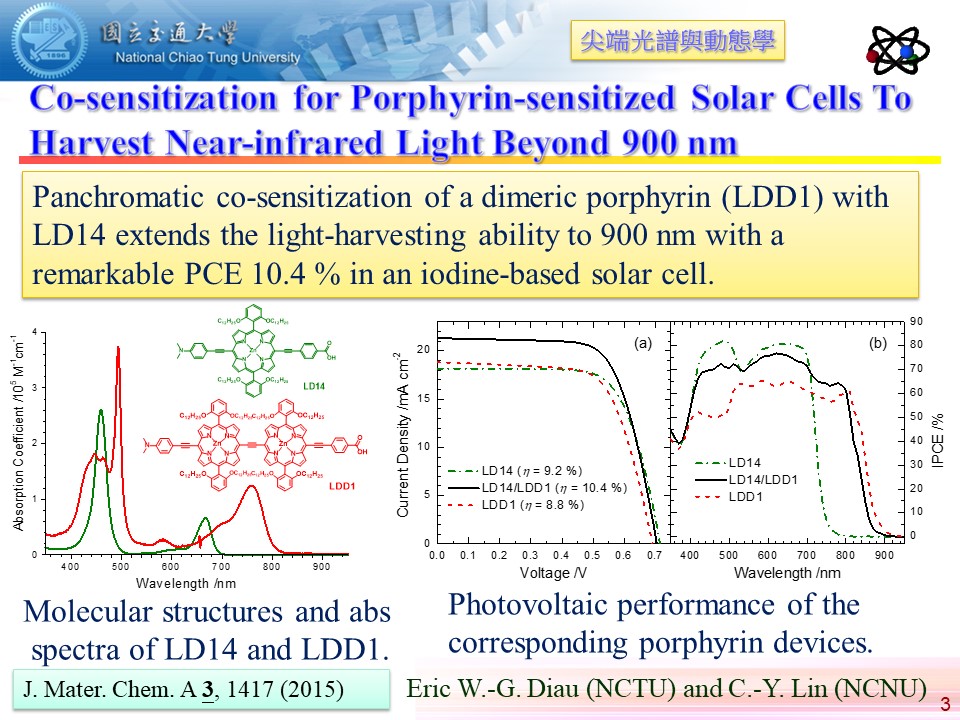


Molecular Engineering of Organic Dyes with a Hole-extending Donor Tail for Efficient All-solid-state Dye-sensitized Solar Cells

A new concept is given for the design of metal-free organic dyes (OD5-OD9) according to an extending D–π–A molecular framework for which the donor terminal unit is attached by a hole-extending side chain to retard back electron transfer and charge recombination. The π–bridge component contains varied thiophene-based substituents to enhance the light-harvesting ability of the device. Co-sensitization of OD9 with a novel porphyrin dye, LW24, enhanced the light-harvesting ability as far as 800 nm, thus achieving PCE 5.5%. Photo-induced absorption (PIA) and transient absorption spectral (TAS) techniques were applied to account for the observed trend of VOC of the devices.
* 148. J. Lu, Y.-C. Chang, H.-Y. Cheng, H.-P. Wu, Y. Cheng, M. Wang and E. W. G. Diau, “Molecular Engineering of Organic Dyes with a Hole-extending Donor Tail for Efficient All-solid-state Dye-sensitized Solar Cells”, ChemSusChem 8, 2529 (2015).
The Cis-isomer Performs Better Than the trans-isomer in porphyrin-sensitized solar cells

Device performance and characterizations were carried out for porphyrin-sensitized solar cells of cis- and trans-isomers of 2D-π-2A zinc porphyrins with carboxyphenyl and thienyl groups on their meso-positions. The overall power conversion efficiencies of 2.44% and 0.88% were obtained for devices made of cis-2S2A and trans-2S2A, respectively. Femtosecond fluorescence decay measurements revealed that the excited-state lifetime of trans-2S2A on Al2O3 is one half of that of cis-2S2A on Al2O3, and the dye-to-TiO2 electron injection time of trans-2S2A is shorter than that of cis-2S2A/TiO2 film.
* 149. L. Luo, R. B. Ambre, S. B. Mane, E. W. G. Diau and C.-H. Hung, “The Cis-isomer Performs Better than the Trans-isomer in Porphyrin-sensitized Solar Cells: Interfacial Electron Transport and Charge Recombination Investigations”, Phys. Chem. Chem. Phys. 17, 20134 (2015).
Highly Efficient Porphyrin-sensitized Solar Cells with Enhanced Light harvesting Ability Beyond 800 nm and Efficiency Exceeding 10 %

Adimeric porphyrin dye (LDD1) based on an efficient push-pull zinc porphyrin (LD14) with extended π-conjugation through coupling of two zinc porphine cores via an acetylene bridge at the meso position of the porphyrin to extend the absorption spectrum effectively into the near infrared region. The light-harvesting ability of the device exhibits a panchromatic feature covering a broad spectral region from 400 nm to 900 nm, which results in a short-circuit current density 21.3 mA cm-2 and power conversion efficiency 10.4 % in an iodine-based solar cell. The IPCE spectral edge of the LD14/LDD1 cell is red-shifted, remarkably, ~100 nm more than for the YD2-oC8, LD31 and perovskite devices.
* 145. J.-W. Shiu, Y.-C. Chang, C.-Y. Chan, H.-P. Wu, H.-Y. Hsu, C.-L. Wang, C. Y. Lin and E. W. G. Diau, “Panchromatic Co-sensitization for Porphyrin-sensitized Solar Cells To Harvest Near-infrared Light Beyond 900 nm”, J. Mater. Chem. A 3, 1417 (2015).